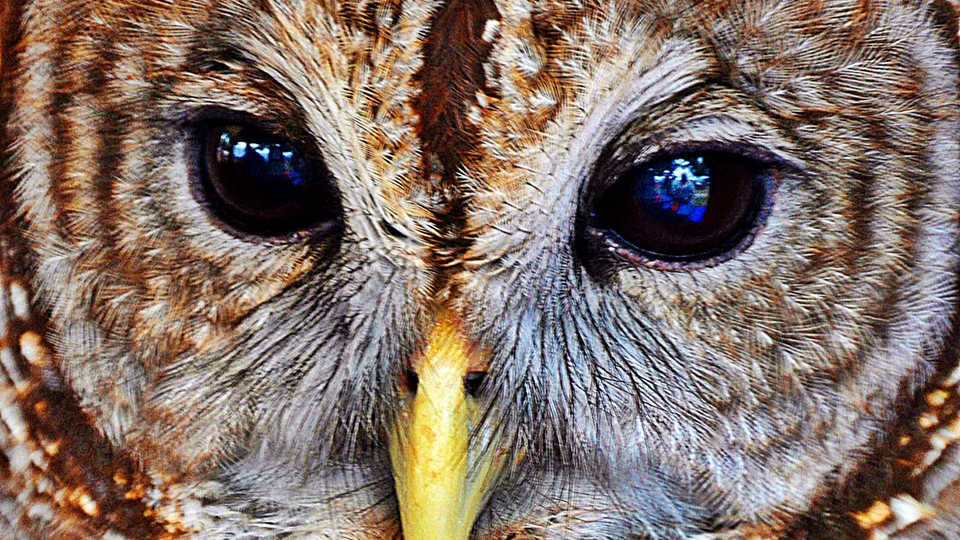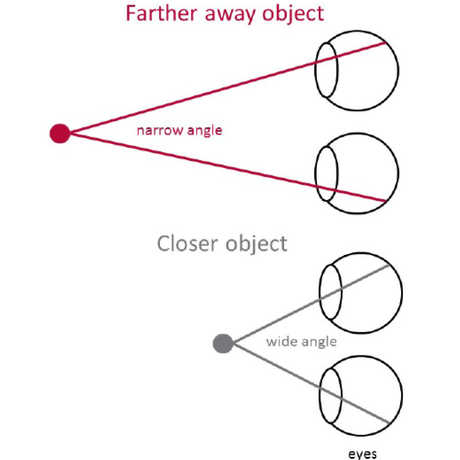Students will be able to:
- experience how parallax contributes to depth perception.
- explain how the phenomenon of parallax is the result of having two eyes.

"Eye in You" © 2015 Mike Cofrancesco
Why do humans have two eyes?
In this simple activity students will discover the concept of parallax and start discussing depth perception.
Students will be able to:
Teacher Tip: Some students may require a little help to get the illusion to work. Here are some trouble-shooting tips:
Discuss the following question as a class:
NGSS CROSSCUTTING CONCEPTS CONNECTION: This portion of the lesson connects to the Practice of Constructing Explanations because students are asked to explain how their two eyes created the optical illusion of a hole in the palm of their left hand. To do this, students will have to make one or more claims and support them with scientific reasoning. Don’t worry if students’ claims are a bit far-fetched at this point. The next activity will help them build their understanding of the phenomenon of parallax.
parallax: the difference in the apparent relative position of objects when they are viewed from different perspectives.
depth perception: the ability to visually judge distances.

Here’s a question you may not have given much thought to before: Why do humans (and many other animals) have two eyes? If you close one eye and take a look around, you should find that you can still see everything pretty well. One eye can see with adequate detail, color, and clarity—so what is the point of having the second eye? While it seems that we should be able to get along just fine with only one eye, you will be hard-pressed to find any one-eyed vertebrates. As it turns out, there are some interesting advantages to having two eyes.
Parallax
The advantage of having two eyes is all about location. Our two eyes are located in different places, and as a result have different perspectives on the world around us.
You can see this effect by holding a pencil out at arm’s length. Look at the pencil with your right eye closed and your left eye open. Then switch eyes. It will appear to you that the pencil has changed position in relation to the background. This effect, called parallax, occurs because each eye is viewing the pencil from a slightly different perspective. In many animals, such as humans, both eyes are facing forward and are fairly close together, so the difference in perspectives is small. Even so, the difference is enough to provide the brain with some valuable information.
Depth perception
Take the pencil that you were holding at arms length and hold it much closer to your face. Then repeat the exercise of looking with one eye, then the other. You should observe a larger apparent change in position than when the pencil was farther away from your face. For objects close to us, there is a big difference in the angles between each eye and the object, so you see the pencil take a big “jump” when you switch eyes. For objects farther away, the angles are much more similar and the “jump” when switching eyes is less noticeable. Our brains use that information to determine how far away objects are. While we are not consciously aware of the differences between the images collected by our left and right eyes, our brains are subconsciously sorting through those differences to calculate how far away each object we see is. Our depth perception, or ability to judge how far away things are, depends largely on the fact that we have two eyes viewing the same objects from slightly different perspectives.
NGSS CROSSCUTTING CONCEPTS CONNECTION: This lesson connects to the Crosscutting Concept of Structure and Function because students are asked to think about why it might be useful for animals (including humans) to have two eyes rather than just one. This question prompts students to consider how a particular structure (two eyes) might function better than another (having just one eye). In Parts 1 and 2, students experience firsthand why having two eyes located in slightly different places creates the phenomenon of parallax, which creates depth perception.
The items listed below indicate how the activities support the three dimensions of the Next Generation Science Standards:
Remember, performance expectations are not a set of instructional or assessment tasks. They are statements of what students should be able to do after instruction. This activity or unit is just one of many that could help prepare your students to perform the following hypothetical tasks that demonstrate their understanding:
4-LS1-1. Construct an argument that plants and animals have internal and external structures that function to support survival, growth, behavior, and reproduction. [Clarification Statement: Examples of structures could include thorns, stems, roots, colored petals, heart, stomach, lung, brain, and skin.] [Assessment Boundary: Assessment is limited to macroscopic structures within plant and animal systems.]
4-LS1-2. Use a model to describe that animals receive different types of information through their senses, process the information in their brain, and respond to the information in different ways. [Clarification Statement: Emphasis is on systems of information transfer.] [Assessment Boundary: Assessment does not include the mechanisms by which the brain stores and recalls information or the mechanisms of how sensory receptors function.]
"Eye in You" by Mike Cofrancesco, licensed and modified under CC BY 2.0; originally sourced from https://www.flickr.com/photos/29350563@N08/16502284767/